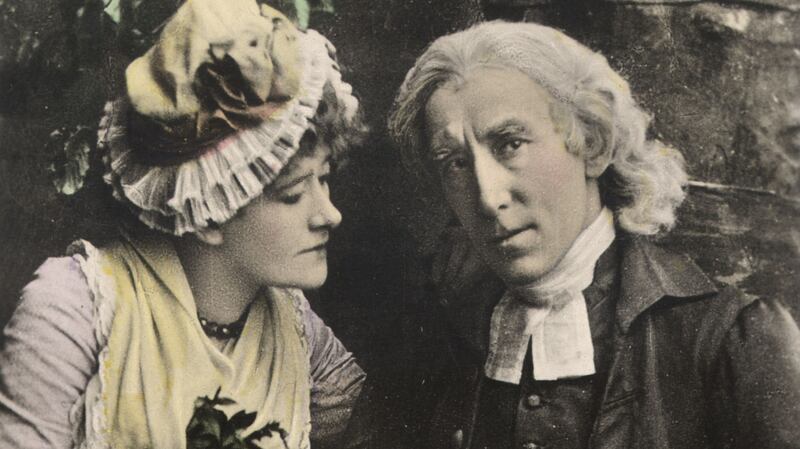
Joseph O’Connor’s enthralling latest novel, Shadowplay, brings to teeming life the London of the late Victorian and Edwardian eras. But at its centre is its displaced protagonist, one Abraham (‘Bram’) Stoker, who has moved from Dublin to London at the behest of Sir Henry Irving, the most acclaimed actor-manager of the day.
When Irving played Hamlet in Dublin in 1878, the 30-year-old civil servant who wrote theatre reviews by night was summoned to the Shelbourne Hotel; there, Irving invites him to come to London and manage his theatre, the Lyceum. The scene of their first encounter is brilliantly stage managed by O’Connor.
Stoker accepts the offer; but adds that he hopes one day to write a play of his own. Irving’s response to this writerly aspiration could hardly be described as encouraging: ‘I have seen nothing in your writing that led me to believe you are an artist, Stoker. Your criticism has sensitivity but you are not a creator.’
Stoker relocates to London where he continues to lead a double life. Bram stage manages every finance-demanding detail of running a large metropolitan theatre while secreting himself away in an eyrie he has discovered at the top of the building to work at becoming a writer, not of plays but of short stories and novels. Stoker’s particular predilection is for ghost and gothic stories. Irving more than once remarks how theatre people are neither fully alive nor dead; they exist rather in the in-between zone of the theatre.
Ellen Terry, the most famous actor of the day, is hired at great expense to act opposite Irving. When he introduces her to Stoker on her first day at the theatre, she goes out of her way to praise the Dubliner’s writing, which Irving has continued to rubbish. The stage (of the novel) is thus set to play out a complex, fascinating triangular relationship between Stoker, Irving and Terry.

Stoker has not come to London alone. He is accompanied by his wife, Florence. Relations between the pair are strained throughout; Bram surmises he has lived on his own too long to adapt to married life. Florence’s back story emerges late in the novel when Oscar Wilde, at the height of his fame and flamboyance, pays a visit to the Lyceum. Stoker he already knows, since they were both students at Trinity.
But there is more. Before she was proposed to by Bram, Florence was proposed to by Oscar: “We were briefly engaged to be married, if you can imagine such a marvel. But she left me for a better man, isn’t that right, Bram? One’s hair quite curled with grief.” Florence wonders whether Bram’s hidden other life at the theatre might not be like that of Wilde.
There is certainly evidence of Stoker’s bisexuality in the gender-fluid space of the Lyceum Theatre, where he is addressed by all of the workers as “auntie” and plays a submissive role to Irving’s hyper-masculine “Chief”. Their relationship is described more than once as a “marriage”.
But what comes across most is Stoker’s isolation and loneliness. He wanders the London streets by night, just as Dickens did, and as Jack the Ripper does in the course of the novel. But this Stoker doesn’t consort with prostitutes, merely gazing at them from the shadows: a classic voyeur.
The cosy, rather sexless menage a trois which develops between Irving, Terry and Stoker is broken up when he discovers the two actors (after a particularly raucous night of celebration) naked in each other’s arms. Stoker seems repelled by their carnality.
All of these experiences find displaced expression in the novel he is currently writing, which will turn out of course to be Dracula. In Shadowplay, O’Connor stalks the emergence of Stoker’s one masterpiece just as meticulously as the Ripper does any of his victims. Irving notes how Dracula draws on the Ripper, a connection which Stoker is keen to deny. But the chief model for the title character, the icy, tall, saturnine nobleman with the hypnotic eyes, is Irving himself, as Terry is the first to recognise.
Shadowplay climaxes memorably with the one occasion on which a play by Stoker is put on at the Lyceum: the one staged performance of the novel required to secure copyright. Irving churlishly refuses to read the part of Dracula or even to attend. After the disastrous reading and a final bitter exchange with Irving, Stoker packs to leave. Irving tracks him to his lair, where he says the one thing to stay the departing manager: the Lyceum is to close.
In a coda, on his last day alive, Stoker attends the cinema and marvels at its technological magic. Fittingly, it is through this new ghostly medium that the greatest success of his most original creation will be achieved.
In one of the few passages from Stoker’s novel quoted directly in Shadowplay, Count Dracula says that he is anxious to fit in to “the whirl and rush of humanity” of London but fears that his imperfect English and his foreignness will always make him stand out.
As O’Connor brilliantly shows, Stoker turns his immigrant status in London, his Irish otherness, to creative account in the writing of Dracula. This 19th-century novel also has a good deal to say about uncertain relations between Ireland and England.















